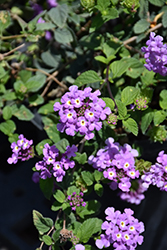Fri & Sat 8am - 8pm
Sun 8am - 7pm
Anytown, USA 12345
fax: 261.787.0463
e-mail: info@successgc.com


Plant Finder

Purple Falls Lantana
Lantana montevidensis 'Purple Falls'
Height: 20 inches
Spread: 20 inches
Sunlight:
![]()
![]()
Hardiness Zone: 8b
Other Names: L. sellowiana; Trailing Lantana
Brand: Ball
Description:
This well branched, trailing variety produces a vibrant display of fuchsia-purple flowers with white centers all summer long; heat and drought tolerant; great for beds, borders, containers, and hanging baskets
Ornamental Features
Purple Falls Lantana features showy cymes of purple flowers with fuchsia overtones, gold eyes and white centers at the ends of the branches from late spring to mid fall. It has attractive green evergreen foliage which emerges chartreuse in spring. The textured heart-shaped leaves are highly ornamental and remain green throughout the winter.
Landscape Attributes
Purple Falls Lantana is a multi-stemmed evergreen shrub with a mounded form. Its average texture blends into the landscape, but can be balanced by one or two finer or coarser trees or shrubs for an effective composition.
This is a relatively low maintenance shrub, and should only be pruned after flowering to avoid removing any of the current season's flowers. It is a good choice for attracting butterflies to your yard, but is not particularly attractive to deer who tend to leave it alone in favor of tastier treats. It has no significant negative characteristics.
Purple Falls Lantana is recommended for the following landscape applications;
- Mass Planting
- Border Edging
- General Garden Use
- Container Planting
- Hanging Baskets
Planting & Growing
Purple Falls Lantana will grow to be about 20 inches tall at maturity, with a spread of 20 inches. It has a low canopy. It grows at a fast rate, and under ideal conditions can be expected to live for approximately 20 years.
This shrub does best in full sun to partial shade. It is very adaptable to both dry and moist growing conditions, but will not tolerate any standing water. It is considered to be drought-tolerant, and thus makes an ideal choice for a low-water garden or xeriscape application. This plant will benefit from an application of bonemeal and/or mycorrhizal fertilizer at the time of planting. It is not particular as to soil type or pH, and is able to handle environmental salt. It is highly tolerant of urban pollution and will even thrive in inner city environments. This is a selected variety of a species not originally from North America, and parts of it are known to be toxic to humans and animals, so care should be exercised in planting it around children and pets. It can be propagated by cuttings; however, as a cultivated variety, be aware that it may be subject to certain restrictions or prohibitions on propagation.
Purple Falls Lantana makes a fine choice for the outdoor landscape, but it is also well-suited for use in outdoor containers and hanging baskets. It can be used either as 'filler' or as a 'thriller' in the 'spiller-thriller-filler' container combination, depending on the height and form of the other plants used in the container planting. Note that when grown in a container, it may not perform exactly as indicated on the tag - this is to be expected. Also note that when growing plants in outdoor containers and baskets, they may require more frequent waterings than they would in the yard or garden.
